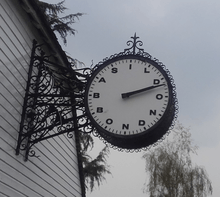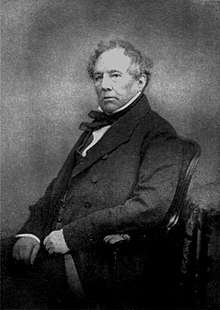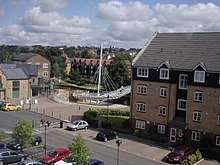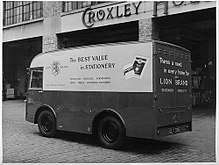John Dickinson Stationery
John Dickinson Stationery Limited was a leading English stationery company founded in southwest Hertfordshire. In the 19th century, the company pioneered a number of innovations in papermaking. It became part of Dickinson Robinson Group in 1966; after changes of ownership, the John Dickinson brand ceased to be used in 2008.
.jpg)
History




John Dickinson began his business life as a stationer in the City of London in 1804.[1][2] But around 1802 he had already started to experiment with papermaking machinery and obtained a first patent for cutting paper in 1807.[3] Two years later Dickinson patented a new continuous mechanized papermaking process.[4] In the same year he gained the financial backing from George Longman, whose family controlled the Longman publishing firm, and formed a new company, called Longman & Dickinson. In addition a considerable sum of money was borrowed from the printer and MP Andrew Strahan (1749–1831).[5]
Dickinson bought his first paper mills at Apsley (a former flour mill) in 1809 and a second one in close by Nash Mill (formerly a mediaeval corn-mill) in 1811. Between 1828 and 1830 he built a third one in Croxley. The canal at Apsley, Nash Mills and Croxley provided power for the mills and transport for materials and product.[6]
The mill-house at Nash Mill, called Nash House, became the family home for Dickinson and his new wife Ann (née Grover), whose father Harry Grover supported this business development through his Hemel Hempstead Bank (now part of Lloyds Bank) in Hemel Hempstead. Soon Nash Mills was renowned for its production of tough thin paper for Samuel Bagster's "Pocket Reference Bible". A major fire in 1813 was a setback, but, being covered by insurance, enabled redevelopment towards large scale production.[6]
During the 19th century, Sir John Evans and his son Lewis Evans (whose elder brother was the archaeologist Sir Arthur Evans) both managed the company. After John Evens had given up his partnership in the company in 1885, it was formally incorporated as John Dickinson & Co. Limited the following year, with a capital of £500,000. At the same time the company started to concentrate more on the stationery side of the business, since papermaking was no longer profitable. The Apsley plant was reconstructed and concentrated on making envelopes, while paper production was transferred to the more modern Croxley Mill.[7]
John Dickinson & Co. Ltd had their Engineering Department at Nash Mills until 1888, when it was transferred to Apsley Mill. By the end of the nineteenth century, Nash Mill, which was small and had a reputation for independence, experienced a drop in profitability. Continuous minor changes were implemented until, in 1926 it underwent improvements with expansion, remodelling and refurbishment. The Lion Brand was adopted as the company logo in 1910.[6] Subsidiaries were then formed in South Africa, Australia, New Zealand and elsewhere (thirteen countries in all).
Basildon Bond

The Basildon Bond brand of stationery was created by Millington and Sons in 1911.[8] The brand is named after Basildon Park, where some of Millington's directors were staying,[9] and they liked the alliteration of "Basildon" and "bond".[8] The Millington & Sons company was acquired by John Dickinson in 1918, who then took over the Basildon Bond brand.[10] The name "Basildon Bond" was used by comedian Russ Abbot for one of his characters.[11]
Innovations
John Dickinson patented a method of papermaking in June 1809, that rendered his rivals' techniques (principally the Fourdrinier machine) obsolete. In 1850, the company started mechanical envelope manufacturing, with gummed envelopes for the first time. The production of fine rag paper on electrically driven machines was a successful innovation at Nash Mill. The company pioneered the production of window envelopes in 1929.
Second World War
The company produced various paper and cardboard products for the war effort, and also branched out into engineering, producing items such as fuel tanks for long range fighter aircraft, 20 mm cannon shells, aircraft fuel pumps, magnetos and spark plugs. The company made the foil strips codenamed Window used by the RAF to blind enemy radar.[12]
Dickinson Robinson Group
Dickinson Robinson Group Ltd (DRG) was formed out of E. S. & A. Robinson Packaging of Bristol and John Dickinson & Co Ltd. in 1966, creating one of the world's largest stationery and packaging companies. In 1989, the asset-stripper Roland Franklin (Pembridge Investments) acquired DRG (by now including the Royal Sovereign group acquired in 1978) in a leveraged buyout worth £900 million.
Fate
Pembridge Investments carved the Dickinson Robinson Group up and sold its parts for a profit to various other companies:
- In 1990 it sold the paper mills in the group – Nash Mills, Keynsham Paper Mill and Fife Paper Mills – to Sappi of South Africa. These mills were subsequently closed by Sappi as were all other acquisitions (Kymmini Oy, Blackburn Mill and Wolvercote Mill) they had made in the UK.
- Also in 1990, DRG Stationery was acquired by Biber Holding AG of Switzerland and renamed John Dickinson Stationery. After Biber became insolvent in 1996, John Dickinson Stationery was sold in the same year to Spicers Ltd, then a subsidiary of DS Smith, and moved from Apsley to the village of Sawston, south of Cambridge. In 2005, John Dickinson Stationery was purchased by the French stationery manufacturer Hamelin Group. Rebranded in 2008 as Hamelin Brands, the company moved to Red Lodge, Suffolk.[2]
- In 1992, DRG Packaging was acquired by Bowater plc (later Rexam).
Frogmore Paper Mill
Just north of the former Apsley Mill site in Hemel Hempstead is Frogmore Paper Mill, the world's oldest mechanised paper mill. It was here that Bryan Donkin first demonstrated the papermaking machine he developed for the Fourdrinier brothers. Now operated by a conservation and education charitable trust, Frogmore Mill is open to the public and incorporates a visitor centre, museum exhibition hall and art gallery as well as continuing to make paper on machine and by hand.
Black n' Red
Black n' Red, a brand of books and pads of paper produced by John Dickinson Stationery Limited, featured a striking black and red design. The front and back covers of such books are black, with the text "Black n' Red" written in red in the bottom right corner of the cover. The spine or bind is also red.
These books are now distributed by the Oxford brand within the Hamelin Group.[13]
References
- "Bicentenary: 1804-2004 The History of John Dickinson". John Dickinson Stationery. 2004. Archived from the original on 12 February 2004. Retrieved 22 January 2015.
- "1804-2008 The History of John Dickinson Stationery". Hamelin. Archived from the original on 17 July 2014. Retrieved 22 January 2015.
- Joan Evans (great nice of John Dickinson): „The Endless Web - John Dickinson & Co. Ltd 1804-1954“, p.9, Jonathan Cape, London 1955
- Joan Evans (great nice of John Dickinson): „The Endless Web - John Dickinson & Co. Ltd 1804-1954“, p.10, Jonathan Cape, London 1955
- Joan Evans (great nice of John Dickinson): „The Endless Web - John Dickinson & Co. Ltd 1804-1954“, p.12-14, Jonathan Cape, London 1955
- "John Dickinson & Co Ltd". Sir John Evans Centenary Project. Ashmolean Museum. 2009. Archived from the original on 20 November 2009. Retrieved 22 January 2015.
- Joan Evans: The Endless Webb - John Dickinson & Co. Ltd. 1804 1954, Jonathan Cape, London 1955, p.132,133 and 135
- Room, Adrian (1983). Dictionary of trade name origins. London: Routledge. pp. 37. ISBN 0-7102-0174-5.
- Basildon Bond. "History". Basildon Bond. Archived from the original on 7 July 2011. Retrieved 5 August 2011.
- "Basildon Bond History". 2012. Archived from the original on 7 July 2011. Retrieved 27 January 2013.
- Sherrie Hewson (4 March 2011). "14". Behind the Laughter. HarperCollins. p. 77. ISBN 9780007412631.
- http://www.dacorumheritage.org.uk/article/dickinsons-at-war/
- "Oxford Black n' Red". www.my-oxford.com. Retrieved 21 June 2019.
External links
- Hamelin
- History of John Dickinson & Co at Grace's Guide
- Frogmore Paper Mill museum site